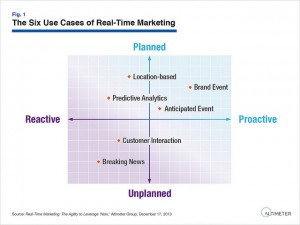
As digital channels operate increasingly in the ‘now,’ all marketing organizations must consider to what degree they will function in real-time, and even define what real-time is relative to their operations and marketing organization.
The payoff? That digital marketing ideal: the right message to the right person at the right time. The right instant, even.
Real-time marketing (RTM) can add tremendous value to customer interactions; making brands appear relevant, with-it, informed, dynamic and buzzworthy. The movement toward RTM is also driven by consumer expectations as immediacy, relevance and access increase with technology.
Our new research report, Real-Time Marketing: The Agility to Leverage ‘Now,’ identifies six business use cases for real-time marketing that fall into a quadrant of planned/unplanned and reactive vs. proactive interactions. In numerous interviews with agency and brand-side practitioners, we found all successful RTM requires enormous strategic and tactical preparation, beginning with a strong , clear and well-defined content strategy.
RTM Use Case #1: Brand Events
Brand events include product launches, conferences, media and customer-facing events where content strategy, pre-approvals, media plans, hashtags, creative, editorial calendars, etc. can be prepared in advance. During events, staff are available to push out content and react to posts in social media.
RTM Use Case #2. Anticipated Event
A growing number of organizations are preparing for real-time events that are anticipated in advance. Business goals, strategies, teams, and approvals are ready, content is locked and loaded.
RTM Use Case #3: Location/object-based
A small but promising use case of RTM taps into location and object-based triggers. Hand-crafted examples of this type of RTM include local food trucks publicizing specials and current locations. Increasingly sophisticated technology, such as iBeacon, target a consumer’s location down to the store-shelf level and push a promotion to that person’s phone in the moment. That’s literally targeting the right person at the right time and the right place.
RTM Use Case #4. Predictive Analytics-based
Another relatively small but growing area of triggered RTM is based on predictive analytics. Amazon has long used predictive data to display recommendations to customers based on browsing and purchase history. This trend will gain momentum as data solutions become more accessible and simpler to implement.
RTM Use Case #5. Customer Interaction
Customer interactions take many forms: CRM, customer service, handling complaints, and community interactions being primary examples. While many organizations handle such interactions to customer service, the very public, visible and occasionally even viral nature of these interactions in social channels means they are increasingly becoming a marketing function. This holds particularly true now that customers have come to expect brands to respond to their digital queries and complaints in near-real time.
RTM Use Case #6. Breaking News
The most reactive form of RTM is responding in a legitimate, relevant manner to unanticipated breaking news. This can also be the riskiest, most spontaneous, and difficult type of RTM. Advance preparation is all but impossible. Breaking news isn’t always good news, so an acute degree of sensitivity is called for. Often, this also requires following a story as it unfolds. The opportunity is hitting it over the fence by appropriately leveraging the event in a way that is relevant, both to the event and to the brand.
As with all Altimeter Group research, Real-Time Marketing: The Agility to Leverage ‘Now’ is available at no cost under Creative Commons. Help yourself! And please let us know your reactions, as well as how your organization is functioning in real-time.
[slideshare id=29152561&doc=reportreal-timemarketing-theagilitytoleveragenowrebeccaliebjessicagroopman-131212115620-phpapp02&type=d]
Cross-posted from the Altimeter Group blog

